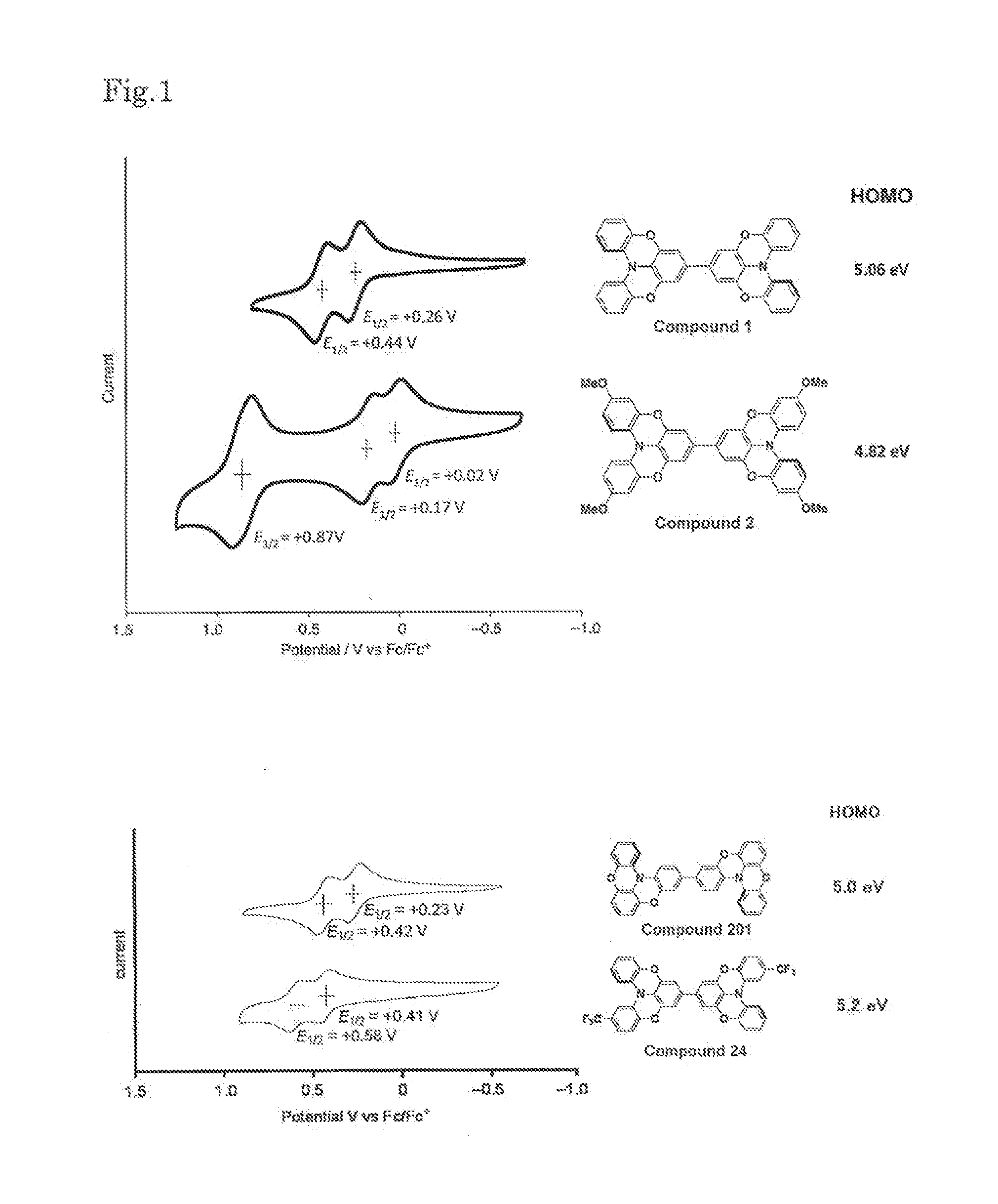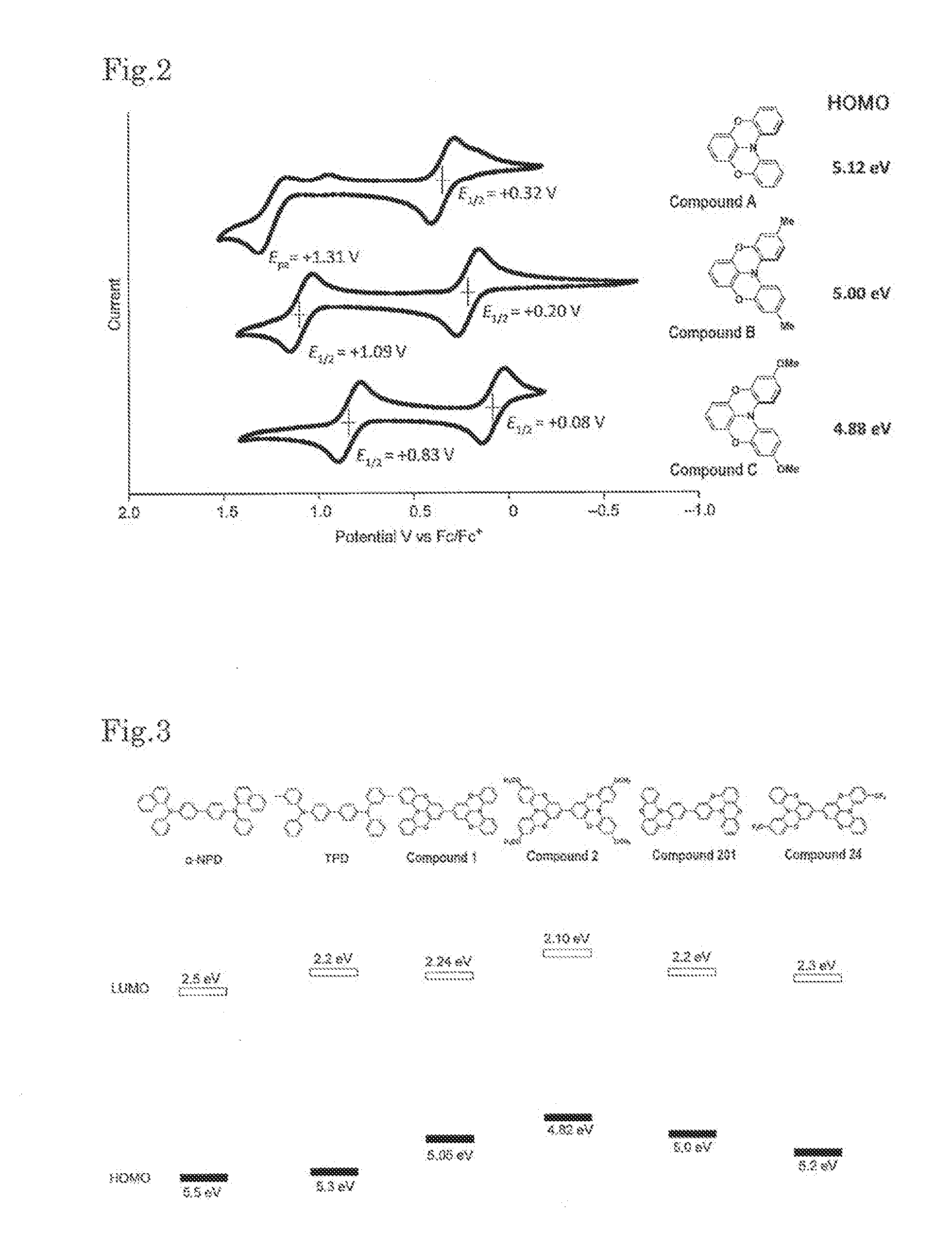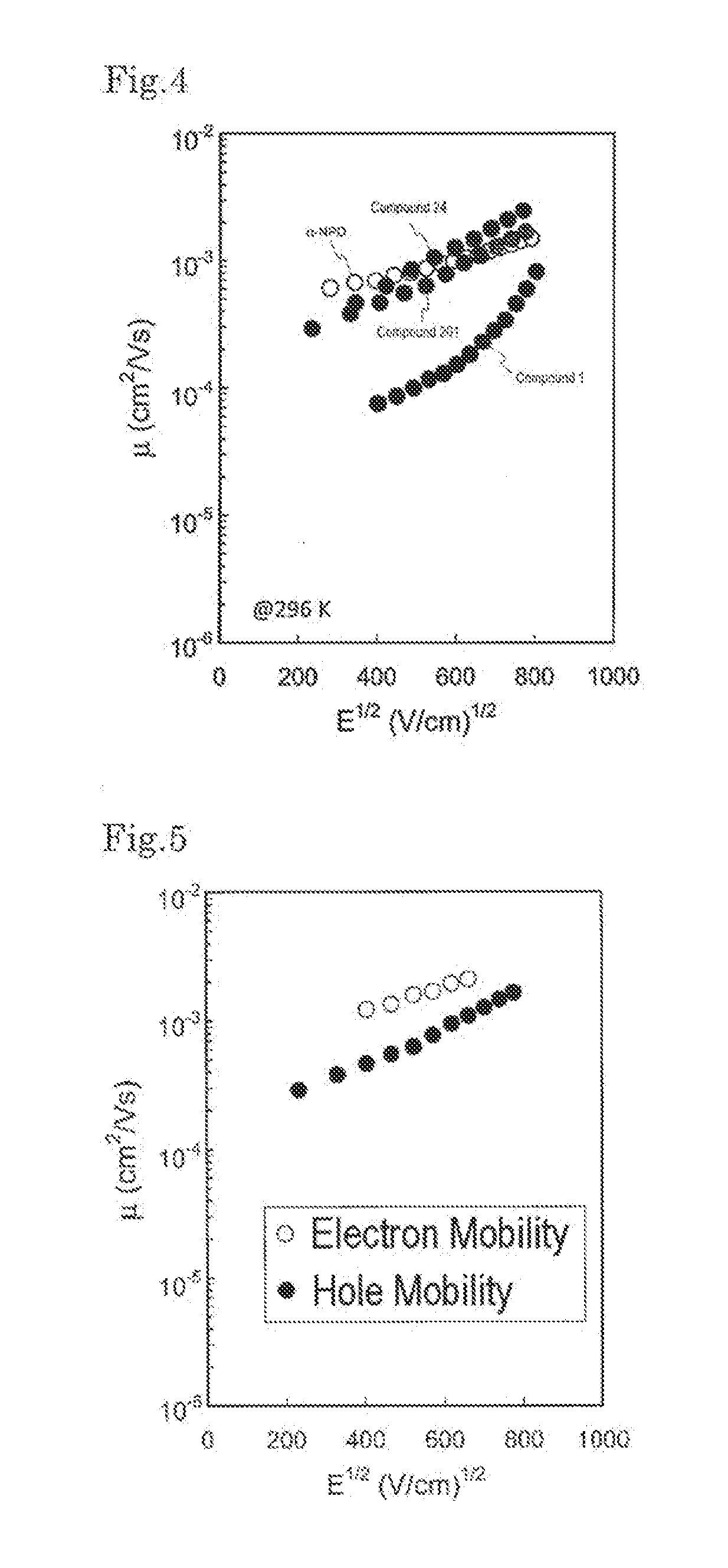Novel compound, charge transport material, and organic device
a charge transport material and compound technology, applied in the direction of group 3/13 element organic compounds, group 5/15 element organic compounds, organic chemistry, etc., to achieve excellent characteristics as charge transport materials, high efficiency, and stable in the amorphous sta
- Summary
- Abstract
- Description
- Claims
- Application Information
AI Technical Summary
Benefits of technology
Problems solved by technology
Method used
Image
Examples
example 1
[0124]Compound 1 was produced according to the following scheme.
[0125]Compound 21a (19.8 g, 84.6 mmol), compound 23a (7.74 g, 37.2 mmol), K2CO3 (21.5 g, 156 mmol), and Cu (7.82 g, 123 mmol) were dissolved in o-dichlorobenzene [ODCB] (100 ml) and heated at 180° C. for 110 hours. The reaction mixture was filtered, and the insoluble matter was washed three times with chloroform (100 ml). The filtrate was washed with water, then dried with MgSO4, filtered and concentrated under reduced pressure. Further, the obtained black solid was washed with hexane to give a white powder, compound 24a (10.6 g, 20.4 mmol) at a yield of 68%. Mp: 157.5-153.5° C.
1H NMR (300 MHz, CDCl3, ppm) δ7.10-6.34 (m, 4H), 6.94-6.81 (m, 6H), 3.60 (s, 6H).
13C NMR (75 MHz, CDCl3, ppm): δ158.24 (dd, 1J (C, F)=252.4, 3J (C, F)=6.9 Hz), 153.25, 136.12, 124.61, 121.10, 115.29 (dd, 2J (C, F)=17.8, 4J (C, F)=9.2 Hz), 114.70 (t, 3J (C, F)=12.0 Hz), 113.00, 56.03.
HRMS (FAB): m / z 419.0325 (M+); calcd for C20H16BrF2NO: 419.0332....
example 2
[0131]Compound 2 was produced according to the following scheme.
[0132]Compound 21b (20.4 g, 77.2 compound 23b (6.86 g, 33.0 mmol ), K2CO3 (18.2 g, 1.32 mmol), and Cu (6.80 g, 107 mmol) were dissolved in o-dichlorobenzene [ODCB] (90 ml) and heated at 180° C. for 150 hours. The insoluble matter was removed through filtration, washed three tunes with CH2Cl2 (100 ml), and the filtrate was wasted with water. The obtained organic phase was dried with MgSO4, filtered, and then concentrated under reduced pressure. Further, this was purified through silica gel column chromatography (developing solvent:hexane / CH2Cl2 (⅓), Rf=0.56) to give a white solid, compound 24b (9.63 g, 20.1 mmol) at a yield of 61%.
Mp: 96.4-97.3° C.
[0133]1H NMR (300 MHz, CDCl3, ppm) δ7.05-6.90 (m, 2H), 6.83 (d, 3J (H, H)=8.4 Hz, 2H), 6.46 (d, 4J (H, H)=2.7 Hz, 2H), 6.38 (dd, 3J (H, H)=8.7, 4J (H, H)=2.7 Hz, 2H), 3.78 (s, 6H), 3.60 (s, 6H).
13C NMR (75 MHz, CDCl3, ppm) δ158.16 (dd, 1J (C, F)=251.9, 3J (C, F)=7.4 Hz), 156.98...
example 3
[0138]Compound 24 was produced according to the following scheme.
[0139]Compound 21c (11.7 g, 49.9 mmol), compound 23c (9.19 g, 44.2 mmol), Pd2(dba)3.CHCl3 (0.799 g, 0.765 mmol), sodium tert-butoxide (4.38 g, 45.6 mmol), and tri-tert-butylphosphine (0.920 g, 4.55 mmol) were dissolved in dry toluene 9100 ml), and stirred at 100° C. for 26 hours. The insoluble matter was filtered, and washed with toluene (60 ml). Subsequently, water was added to the filtrate, and extracted with toluene (50 ml×3). The organic layer was dried with Na2SO4, filtered, and the filtrate was concentrated under reduced pressure. The obtained solid was purified through silica gel column chromatography (CH2Cl2 / hexane=1 / 5, Rf=0.30) to give a white solid, compound 24c-pre (7.73 g, 24.6 mmol) at a yield of 50%.
Mp: 71.2-72.2° C.
[0140]1H NMR (300 MHz, CDCl3, ppm) δ7.20-7.11 (m, 2H), 6.91-6.80 ppm (m, 3H), 6.57 (td, 3J (H, H)=8.7 Hz, 4J (H, H)=2.7 Hz, 1H), 5.83 (s, 1H), 3.93 (s, 3H).
13C NMR (75 MHz, CDCl3, ppm) δ156.67...
PUM
 Login to View More
Login to View More Abstract
Description
Claims
Application Information
 Login to View More
Login to View More - R&D
- Intellectual Property
- Life Sciences
- Materials
- Tech Scout
- Unparalleled Data Quality
- Higher Quality Content
- 60% Fewer Hallucinations
Browse by: Latest US Patents, China's latest patents, Technical Efficacy Thesaurus, Application Domain, Technology Topic, Popular Technical Reports.
© 2025 PatSnap. All rights reserved.Legal|Privacy policy|Modern Slavery Act Transparency Statement|Sitemap|About US| Contact US: help@patsnap.com



